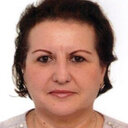Immunohistochemical reaction of the glandular epithelium in endometrial hyperplasia compared to endometrial carcinoma.
Ключови думи
Резюме
The histopathological and immunohistochemical diagnosis of endometrial biopsies is used for estimating the risk of progression in endometrial hyperplastic lesions in carcinoma and for guiding the clinical management. The objective of this study was to evaluate the immunohistochemical expression of the estrogen receptor (ER) and progesterone receptor (PR), p14, p53, phosphatase and tensin homolog (PTEN), Ki67, in patients with endometrial hyperplasia (EH) with/without atypia versus endometrioid endometrial carcinoma type 1. After the histopathological determining of the lesion type at endometrial level, the cases were studied using immunohistochemical methods, namely by the use of an antibody panel. The immunohistochemical staining of PR was nuclearly and cytoplasmatically positive in EH with/without atypia and cytoplasmatically negative in endometrioid carcinoma, and in ER, the immunohistochemical staining was cytoplasmatically negative in the forms of EH without atypia and positive in various stages of intensity in the rest of the cases. The immunohistochemical staining of p14 was moderately expressed in the endometrioid carcinoma and negative in EH without atypia at nuclear level, and at cytoplasm level, it generally had a positive expression. In our study, the nuclear and cytoplasmic study of immunoxpression p53, both in hyperplastic lesions and in the endometroid endometrial carcinoma, was negative, similar to the immunohistochemical expression of PTEN. At nuclear level, the immunohistochemical staining of Ki67 was positive in EH with atypia and in endometrioid endometrial carcinoma, while at cytoplasm level, it was positive only in endometrioid endometrial carcinoma. The nuclear and cytoplasmic study of this immunohistochemical marker panel shows a different reactivity in EH with÷without atypia and endometrioid endometrial carcinoma.





